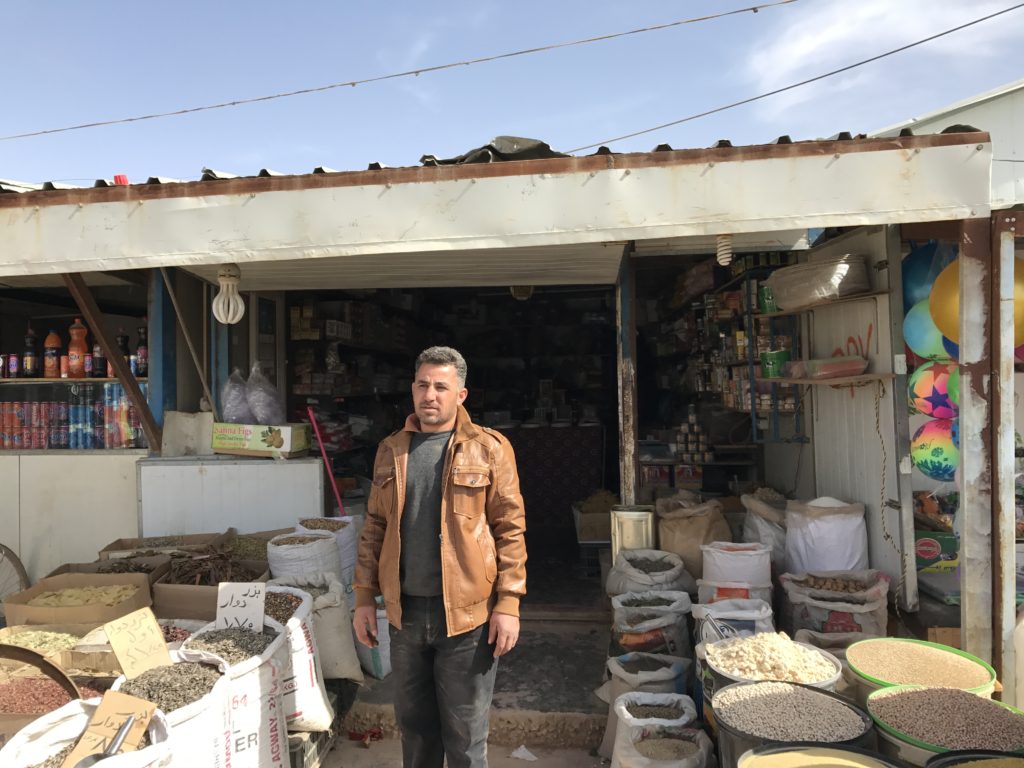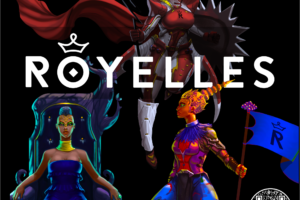
When Zulfiqar Deo and Ondrej Dusilek first visited Jordan in 2016 to conduct interviews in the Zaatari UN refugee camp, they found a paradox. Nearly a hundred thousand refugees, displaced by the war in Syria, were living in a ‘camp’ that’s looking more and more like a permanent settlement every year. Many of these refugees were educated professionals or business people in Syria. But in Zaatari they’re not allowed to work. Though the Jordanian government provides $870 million in annual support, they have restrictions on refugee work permits in order to protect their own economy.
Nevertheless, businesses naturally pop up in a community of this size. Deo, who was detained at the airport, communicated with Dusilek and their support team in the camp, including advisors from PriceWaterhouse Cooper and SIX Group, a coach and mentor from the F10 fintech incubator, and a handful of volunteers. They estimated that three thousand microbusinesses helped circulate $11 million per month in the Zaatari community.
Invisible Businesses
Without access to capital, though, the refugee’s businesses were struggling. A wedding dress rental company couldn’t grow to meet the demands of the community. A baker wanted to scale up his shop but couldn’t afford the machine that would make it possible. “Refugee entrepreneurs are a significant global population not being served,” Deo told The Block Talk earlier this week. “They cannot access a business bank account. They have no formal record that their business even exists,” says Deo. “Even as successful entrepreneurs, they’re financially excluded.”
This ‘significant global population’ is growing fast. Over 68 million people worldwide have been displaced by violence, and that number is growing by 300 thousand people each year. If this unprecedented upsurge continues, we’re looking at a near future in which one out of every 100 people on earth is a refugee.
Part of the refugee experience is disconnection. But we have the technology to connect people. Can we introduce it to regions like Zaatari to engage refugees more directly with the global community? Can we use the blockchain to finance refugee entrepreneurs and stimulate micro-economies in camps and settlements?
Boosting the World’s Underserved Through Technology
That’s the thinking behind BizGees, the company Deo and Dusilek launched to bring microfinancing to refugees. They want to support refugee-owned small businesses with interest-free loans, inventory, six months of ongoing support, and access to amenities from partner companies, like WSV’s ‘business in a box’ toolkit. By Deo’s calculation, a support package like this lowers the risk of business failure from 90 percent (which is close to normal for first time entrepreneurs, although these numbers are tricky to nail down) to a mere 10 percent.
“Refugees naturally nurture the same skills entrepreneurs have just out of necessity,” Deo observes. He notes that the creativity, initiative and ownership necessary for their survival are also traits commonly associated with entrepreneurs. “So why not support them?”
With the support packages Deo designed, 3-5 refugees who typically live on $5 per day could launch a startup or expand an existing microbusiness. Within a year, the microbusiness could become a small business employing 10 more people, who circulate their pay in the local markets and stimulate the whole community. When the loan is repaid after a year and a half, it’s reinvested, providing loans to another business.
Eventually, because of the transparent, chronological way the blockchain stores data, refugee entrepreneurs will build a credit history acceptable to most local banks, better positioning them for traditional finance like they may have had access to back home.
Finding The Right Environment
But there was a problem. Although their model is tested, BizGees couldn’t launch it in Zaatari because of the government’s work restrictions. “We had to move away from Jordan,” Deo said a bit ruefully, “and look for a different environment that allows refugees to work.” That led his team to Uganda, where tens of thousands of refugees have been displaced over the past decade by violence from a Christian terrorist group called the The Lord’s Resistance Army (LRA), operating in northern Uganda, South Sudan, the Central African Republic, and the Democratic Republic of the Congo.
According to Deo, some of the people in Uganda’s camps “didn’t take kindly to the service we were offering at first, asking ‘why is that person getting support and not us?’”
They had to work to re-educate the community on how the model brings long-term returns to everyone, by the money getting re-loaned and by financially stimulating local marketplaces. Now, Deo says, they’ve identified the refugees they can fund and the first microbusinesses should be up and running by the end of this month.
Working in Stressed Communities
Working in refugee camps isn’t easy. “It’s a very complex environment,” Deo says. “In addition to the financial issues they’re facing, there are social issues, psychological issues, most of them have post traumatic stress.” He notes that displacement alone causes mental health concerns, let alone the trauma of losing or being separated from loved ones. “You have to take into account the impact those traumas have as far as how they engage with the public and how they take control of their own lives.”
Consequently, the goal of BizGees isn’t just financial or technological. Their website asserts the importance of entrepreneurship as a way for people to take back ownership of their lives by building confidence and self-worth. Instead of just trying to make a buck, Deo, who has a background in international politics and NGOs as well as business, wants to meet a need.
How Crowdfunding Meets These Needs
BizGees is able to offer loans without interest or collateral because of the way they crowdfund them. Ninety percent of everything they raise goes to the refugees, while the other 10 percent supports BizGees’ operations, which are partially volunteer run.
The public participates through crowdfunding campaigns including art auctions, presales of products from post conflict zones, and cryptomining.
“The reason we’re using crowdfunding is to engage the global community more directly with the refugee experience,” says Deo. “The idea is to personalize it and help individuals to make a real social impact.”
Through blockchain’s ability to connect people directly without a third party, Deo sees a future where a group of individual financiers could get together to sponsor one refugee microbusiness and communicate with them directly. “They’re no longer reliant on third parties to know what’s going on in rural Uganda,” he says. “They have direct access.”
Getting People Socially Engaged
Direct communication is key because it creates the social engagement that is one of Deo’s overarching goals. Most people have no idea what a refugee camp is like, who’s in them, or what they’re facing on a day to day basis, he notes, citing that the average refugee stays on what’s supposed to be a temporary refugee status for 17 years (the U.S. State Department says 26 years on average for protracted refugees). “The support base for refugees is focused on disaster relief, for the first 6 months or so,” Deo says.
“There’s a big gap between the actual experience of refugee populations across the world and how we perceive their experiences,” he says. “We’re looking to use social engagement as a way to narrow that gap as much as possible.”
That’s also why he’s enlisting volunteers to participate in the work, both on the ground in the refugee camps and at BizGee’s headquarters in London. Deo mentioned an American volunteer who came to help with promotional material, website stuff, and office operations. “Her understanding of the refugee experience on day one was very different than it was on week seven,” he says. That in itself he considers a small success.
Goal: A Thousand Refugee Businesses Thriving
As for larger successes and longer term goals, Deo hopes to support 1,000 refugee businesses in the next three years, serving populations indefinitely in Latin America and Asia as well as Africa.
Blockchain technology can work for humanity. Models like Deo’s, which supports at least seven of the UN Sustainable Development Goals, identify something the blockchain can do that world badly needs. This is what we need to see more of from blockchain developers.
The refugee crisis is escalating, but hope can grow within the camps as long as people can live like people. As long as bakers can keep baking, and families can rent their wedding dresses.

















Whoa! This blog looks exactly like my old one! It’s on a entirely different subject but it has pretty much the same layout and design. Superb choice of colors!
As the admin of this web site is working, no question very rapidly it
will be renowned, due to its feature contents.
Hi my loved one! I wish to say that this post is awesome, nice written and include approximately all vital infos.
I’d like to see extra posts like this .